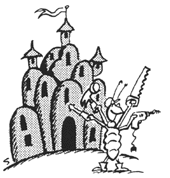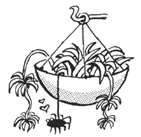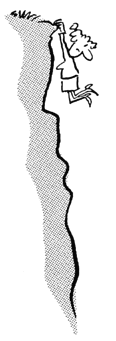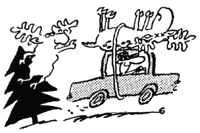
Principles
Complexity lens
Tune to edge
Metaphor
Paul E. Plsek & Associates
| The basic idea: |
Using discussion of an analogous system as a way
to help people get common and creative insights into the operation of the CAS they are in.
Tales
Inter-departmental
communication
Another way to think
Make it or let it
Teamwork in HMO clinics
Bibliography
Morgan:
Images
Morgan:
Imaginization
| Potential context for use: |
Members of the group have differing, but largely unexpressed, views of the mission, purpose, or method of working together.
The group seems stuck in its approach to issues (stuck on an attractor) and needs some creative insight.
| Description: |
Metaphor is a tool of language in which one thing
is said to be something else (or to be like something else). Exploration of the
similarities and differences between the two things gives a group a way of thinking and a
way of seeing a situation that can bring creative insight about ways to move forward. For
example, we might say: "We want our HMO clinic teams to function as well as the NASA
space shuttle team" and then explore the implications of this statement.
The predominant metaphors in use in organizations today
are those of a machine and a military operation. If an organization is a machine, then we
just need to specify the parts well, and make sure each part does its part. If an
organization is a military operation, then command, control, and communication needs to be
hierarchical, survival is key, and sacrificial heroes are desired (although no one really
wants to be one themselves). Most of today's organizational artifacts-job descriptions,
organization charts, root-cause analysis, "turf battles," and so on-emerge from
these largely unexpressed and undiscussed metaphors.
Diffusion
Paper tear
The basic problem with
these metaphors when applied to a CAS is that they ignore interaction effects among the
agents, or worse, simply assume that these interactions can be tightly controlled through
better (read: more) specification. While there are many situations in health care where
the machine and military metaphors are useful-for example, a "code blue team" or
a surgical process-there are also many situations where these metaphors are grossly
inadequate.
When we use the tool of metaphor in a CAS we are
seeking to make explicit the metaphors that guide interactions within the system, and we
are seeking new metaphors that can provide fresh insight into the dynamics of the system.
Bibliography
Morgan:
Imaginization
Gareth Morgan suggests a
number of generic metaphors that we can use to create dialogue and shared meaning within
groups. Several of Morgan's generic metaphors are described in the attachment. A
facilitator can introduce these metaphors and challenge the group to extract key themes
that can then be applied to the real-world CAS with which the group is concerned.
| Reflection: |
Before using this aide: What metaphors
is the group unconsciously using in its current approach?
After using this aide: How will the group
transform its new insight into action? What plan do we have for keeping the new metaphor
alive so that we don't slip back into the old metaphor?
| Examples: |
There are several examples in the Tales of
Complexity section that illustrate the use of metaphor to help provide new insight into
common organizational issues. In addition to the Tales cited in the margin, see also the
various books and articles described in the Bibliography.
| Facilitator's Tips: |
Break large groups into smaller groups of 2-4 people. Encourage diversity by allowing the small groups to work on different metaphors, or different angles of the same metaphor. Quick agreement and over-simplification works against what we are trying to accomplish.
Before you set the groups to work, use the examples we provide, or your own anecdotes, to illustrate what metaphor is intended to accomplish. Concrete and highly analytical thinkers will flounder without some guidance as to what they are supposed to do with the metaphors.
Beware of taking metaphors too literally. As a facilitator, help the group identify key themes from the world of the metaphor, but then immediately pull them back into the world of the CAS under discussion and ask for concrete suggestions for how this theme applies in the real world. Expect to cycle back and forth several times between the world of the metaphor and that of the real CAS.
Bibliography
Morgan:
Imaginization
| Attachments: |
Some of Gareth Morgan's Generic Metaphors
The eight metaphors described below are just a few of
the literally infinite number of useful metaphors. They are described here to pique your
interest and imagination. The best metaphors are those that emerge during discourse with
others within a CAS.
|
Strategic Termites. Termites are master builders. Termite mounds are
intricate affairs that are the tallest structures on earth when compared to the height of
their builders. But every termite mound is unique; there does not appear to be a
detailed blueprint that the insects follow. Instead, Morgan points out, "The
'masterpiece' evolves from random, chaotic activity guided by what seems to be an overall
sense of purpose and direction, but in an open-ended manner." Example of a provocative question for a group:
|
|
|
Spider Plants. Spider plants are commonly found in hanging
baskets. There is a central plant in the basket, rooted in soil. From the
basket, the plant sends out long stems a foot or so in length;
"tentacles." At the ends of these tentacles are clumps of leaves.
Morgan suggests drawing a picture or bringing in an actual spider plant to stimulate
creative discussions about centralization versus decentralization issues in organizations. Example of a provocative question for a group:
|
Tales
Another way to think
Political Football or Tug-of-War. Many organizational issues have important political
aspects to them. Powerful groups and individuals, often with hidden agendas, are at
play within the CAS. Technical or process-oriented solutions to issues can fail
miserably if the political aspects of the issue are not acknowledged openly and
addressed. To make the political dimension of the CAS discussible, Morgan suggests
the metaphor of the issue as a political football or tug-of-war. Since the
discussion is uncomfortable, several rounds of dialogue may be needed, but this aspect of
the CAS becomes more potentially tractable with each such round.
|
|
Self-Organizing "Blobs." Morgan suggest that images from nature such as octopi,
amoebas, spiders, and dandelions can help groups better visualize creative ways to
organize and accomplish their purposes.. All of these "blob" metaphors
focus discussion on aspects of self-organization and adaptability in accomplishing a
purpose. Example of a provocative question for a group:
|
|
|
The Gulf The gulf is a metaphor for the deep organizational pool
into which people and issues can fall, never to emerge again. Everyone in the
organization knows (or learns quickly) about the gulf. Everyone knows (or learns quickly)
that venturing into the gulf is a "career limiting move." An example of an
organizational gulf might be: challenging policies or programs that come down from
headquarters. Even if the policies or programs are obviously flawed, and everyone
seems to know it, people have learned from past experience that it is personally damaging
to say anything. Silence is one of the main factors surrounding and sustaining the
gulf. Morgan suggests that naming the gulf is helpful, because it breaks the silence
but provides a sager, depersonalized way to discuss it. |
Example of a provocative question for
a group:
|
|
Deerhunting.
(Morgan attributes this metaphor to his colleague Lin
Ward.) "Deerhunters set out for the forest, shoot a deer, and carry it back home.
Right? Well, not exactly. They carry the body back, but the essence of the living deer
remains in the forest." Organizations often do the same thing when they
"implement programs" such as quality management, empowerment, visioning, and so
on. They have the artifacts to show that they did the program, but they do not have the
"living essence" of the ideas that underlie the program. False information about
a false reality spreads through the CAS of the organization degrading the chances for
positive, emergent behaviors. As with the Gulf, the Deerhunting metaphor gives a name to
this phenomenon and provides a means for discussing what is happening. |
|
Example of a provocative question for a group:
|
|
Bibliography
Briggs:
Fractals
Zimmerman:
Breaking
Holograms (or Fractals).
A hologram is a three-dimensional photograph; you've
seen them in shops or on credit cards. An interesting property of a hologram is that if
you cut it into pieces, each piece displays the entire picture! Similarly, look at a tree.
The branching structure of the tree is basically the same from the trunk all the way out
to the ends of the limbs. Whether you look at the tree as a whole, or break off a branch
and study it alone, the number and style of branches at a branch-point is a characteristic
feature of the type of tree you are looking at. This property of a unit of structure that
is replicated at various levels is a harmonious, self-organizing feature of nature.
We can use this metaphor in exploring more harmonious
organizational structures by focusing on the need to build an organizational
"kernel" and then replicate this at all levels of the organization. For example,
imagine a leadership "kernel" consisting of a trio of a physician, nurse, and
administrator who accept collective accountability for the success of whatever they are
charged to oversee. Once we understand this "kernel," the hologram or fractal
metaphor suggests that we should establish such leadership trios at all levels of the
organization. If there is a level at which these three have a separate, not collectively
accountable structure, there may be dys-harmony in the CAS.
Aides
Min Specs
Example of a provocative question for a group:
What is the "kernel" of organizational structure we need here? What are the "minimum specifications" for that kernel? Are we maintaining harmony by truly using the same kernel at all levels of the organization?
Team Metaphors.
"Team" is an over-used and under-defined word
in current organizational jargon. Everyone is forming teams; everyone knows they need to
be a good "team player" in order to be successful. But there are many, diverse
images of a good team and how it operates. Successful team behavior is very different when
one is on a basketball team (where fluid flow is valued), versus a baseball team (where
roles are very clearly defined), versus a community theater group (where all roles are
important but some get more visibility than others), versus the NASA space shuttle team
(where technical expertise and detailed planning are key). In general, it is not a good
assumption to image that everyone in a CAS has the same mental picture of how they should
interact on a "team." Explicit discussion is very valuable.
Example of a provocative question for a group:
- What type of "team" are we?
Next | Previous | Return to Contents List
Copyright © 2001, Paul E. Plsek
& Associates,
www.directedcreativity.com Permission to
copy for educational purposes only.
All other rights reserved.




